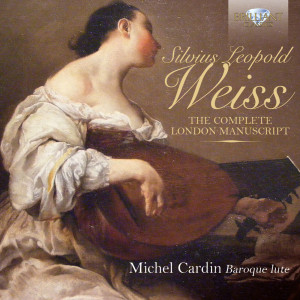Silvius Leopold Weiss
Story
Silvius Leopold Weiss was a German composer and lutenist, the master lutenist of the 18th century and one of the greatest players of all time. He was born into a lute-playing family: his father Johann Jakob (1662-1754) and brother Johann Sigismund (c1690-1737) were also lutenists of distinction. Silvius Leopold and first learned the instrument from his father.
In 1706, Silvius Leopold Weiss made his professional debut in the Breslau court, in which his family served. Weiss’ extraordinary talent gained the attention of Elector Johann Wilhelm, dedicatee of Arcangelo Corelli’s Op. 6 and an intelligent patron of music. Weiss served in Wilhelm’s court in Düsseldorf for the next two years, and his earliest known compositions date from this time.
In 1708 he was engaged by the former Polish queen, Maria Casimira, as a musician in the service of her son Prince Alexander Sobieski, who travelled to Rome to join her there in that year. Weiss left Düsseldorf for Rome and resided in the Zuccari palazzo until 1714, absorbing new Italian styles firsthand and touring with the Prince to various courts. By the time of the Prince’s death, Weiss’ reputation was already well established, and he spent the next several years touring the continent and taking fixed employment only briefly. In Prague he met the prominent Bohemian lutenist Count Johann Anton Losy, whose work had a considerable impact. After Losy’s death, Weiss would write a memorial Tombeau that remains one of most eloquent works.
In 1714 Silvius Leopold Weiss returned to Germany and briefly served at the Hesse court at Kassel. In 1717 he first played at Dresden, and in 1718, weary of wandering, he decided to settle into a lucrative post offered him at the court of Dresden in the famous orchestra of the Saxon elector and King of Poland, August the Strong. Though this did not prevent him from travelling on occasion, Dresden would serve him as home base for the rest of his life. Attempts to dislodge Weiss from Dresden made by representatives of the Vienna Court, including princely sums of money offered, went ignored. Weiss is known to have met with the violinist Franz Benda in 1738.
At his death in 1750, Silvius Leopold Weiss was 66 years of age. He was, and still is, regarded as the greatest of all lutenists, and the instrument fell into decline within two decades of his death. An evaluation by the Markgrafin Wilhelmine de Bayreuth, sister of Frederick II of Prussia and herself a composer, would serve well as epitaph; “(Weiss) excels so much in playing the Lute that no one has ever matched him, and those who will come after him will only be left with the glory of imitating him.” Sylvius Weiss’ son Johann Adolph Faustinus Weiss succeeded him as a Saxon court lutenist.
Silvius Leopold Weiss was one of the most important and most prolific composers of lute music in history and one of the best-known and most technically accomplished lutenists of his day. He wrote around 600 pieces for lute, most of them grouped into ‘sonatas’ (not to be confused with the later classical sonata, based on sonata form) or suites, which consist mostly of Baroque dance pieces. Weiss also wrote originally extensive repertory of chamber music, lute duets, and concertos, but only the solo parts have survived; in every case the parts that accompany the solo lute are lost. Some of his “Suonate” (Weiss’ own term) for solo lute, which have come down to us in a variety of tablature manuscripts, are missing their preludes, which were usually improvised. Seventy suites, however, are known in their entirety; most last about 20 to 25 minutes in performance. As a composer, Weiss shows extraordinary originality; his suites stand comparison with those of J.S. Bach. Only one of the suites, No. 49 in B flat minor, appeared in print during Weiss’ own lifetime; his work was not intended for amateur players but for virtuosi whose skills approached his own. A modern printed edition of Weiss’ complete works has been underway since 1980.
Weiss’ music is characterised by a unique understanding of the capabilities of his instrument, its strengths and its weaknesses; like J.S. Bach’s, it represents the culmination of a high Baroque style a little at odds with the more progressive aspirations of his younger contemporaries. Weiss was also in demand as a teacher. His many aristocratic pupils included the young Frederick the Great and his sisters Wilhelmena (later Margravine of Bayreutlt) and Anna Amalia, Princess of Prussia, and his otter pupils included the lutenists Adam Falckenhagen and Johann Kropfgans.
Silvius Leopold Weiss’ skill as a player and accompanist was legendary, as were his powers of improvisation.
Details
- Composer
- Silvius Leopold Weiss
- Date of birth
- October 12, 1687
- Nationality
- German
- Albums
- 4
- Tracks
- 251
4 albums
-

Manuel de Falla, Francisco Tárrega and 10 others
Nocturne, Romantic Guitar Miniatures
-

Silvius Leopold Weiss and Johann Georg Pisendel
Pisendel: Violin Sonatas
-

Silvius Leopold Weiss
Weiss: Sonatas for Transverse Flute and Lute
-

Silvius Leopold Weiss
Weiss: The Complete London Manuscript
